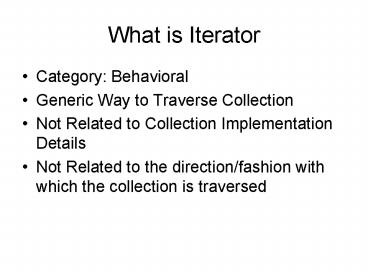What is Iterator - PowerPoint PPT Presentation
1 / 9
Title:
What is Iterator
Description:
Not Related to the direction/fashion with which the collection is traversed. How to ... Avoids the ugly, and sometimes bug-prone index/cursor management (int i ... – PowerPoint PPT presentation
Number of Views:43
Avg rating:3.0/5.0
Title: What is Iterator
1
What is Iterator
- Category Behavioral
- Generic Way to Traverse Collection
- Not Related to Collection Implementation Details
- Not Related to the direction/fashion with which
the collection is traversed
2
How to Use Iterator
- Implementation Details
- Have a class (Class A) with which iteration makes
sense - Create a class (Class B) that implements the
java.util.Iterator interface - Class B should manage the iteration state over
Class A for a single client. - Usage Details
- Call constructing iterator() method on collection
object. - Use Iterator object returned to iterate elements
(next(), hasNext())
3
How to Use Iterator
- Example Iterator implementation (note similar to
actual Java implementation) - // Note Some features are not implemented
- public class VectorIterator implements
java.util.Iterator - private Vector collection
- private int cursor0
- public VectorIterator(Vector toIterate)
- collection toIterate
- public boolean hasNext()
- return (cursor lt collection.size())
- public void next()
- cursor
- Object next collection.get(cursor)
4
How to Use Iterator
- Traditional Looping
- Vector aVector new Vector()
- // load vector with elements
- // Implementation omitted
- for(int i0 iltaVector.size()i)
- Object anElem aVector.get(i)
- Iterator Looping
- Vector aVector new Vector()
- // load vector with elements
- // Implementation omitted
- Iterator elements aVector.iterator()
- while(elements.hasNext())
- Object anElem elements.next()
5
Class Diagram
- From (Stephen Stelting, Olav Maassen, Applied
Java Patterns)
6
Why Iterator
- Hides details of Collection Traversal
- Avoids the ugly, and sometimes bug-prone
index/cursor management (int i) - The iterator pattern can be used to disperse the
cost of expensive object construction
7
In the Real World
- Java has built in Iterator Support for the
Collections Library (java.util.Iterator) - Vector, ArrayList, LinkedList, HashSet, TreeSet,
etc (Collection.iterator() method). - Iterator may be traversing an Array, a
LinkedList, or even a binary tree, but the code
using the library knows no difference. - Developers can reuse the Iterator interface for
their own libraries/implementations
8
In the Real World
- Iterator can be used to defer expensive reads
such as database calls and file parsing until it
is actually necessary. - In combination with the factory pattern,
collection type choices can be completely
abstracted from the program, and into
configuration files.
9
Advanced Java Examples
- public class CollectionsExample
- public static void main(String args)
- Collection collectionA null
- collectionA createCollection(args)
- iterateCollection(collectionA)
- public static Collection createCollection(String
args) - Collection collection null
- if(args0.equals(Vector))
- // returns a index based list walking iterator
- collection new Vector()
- else if(args0.equals(TreeSet))
- // returns a tree walking iterator.
- collection new TreeSet()
- return collection































